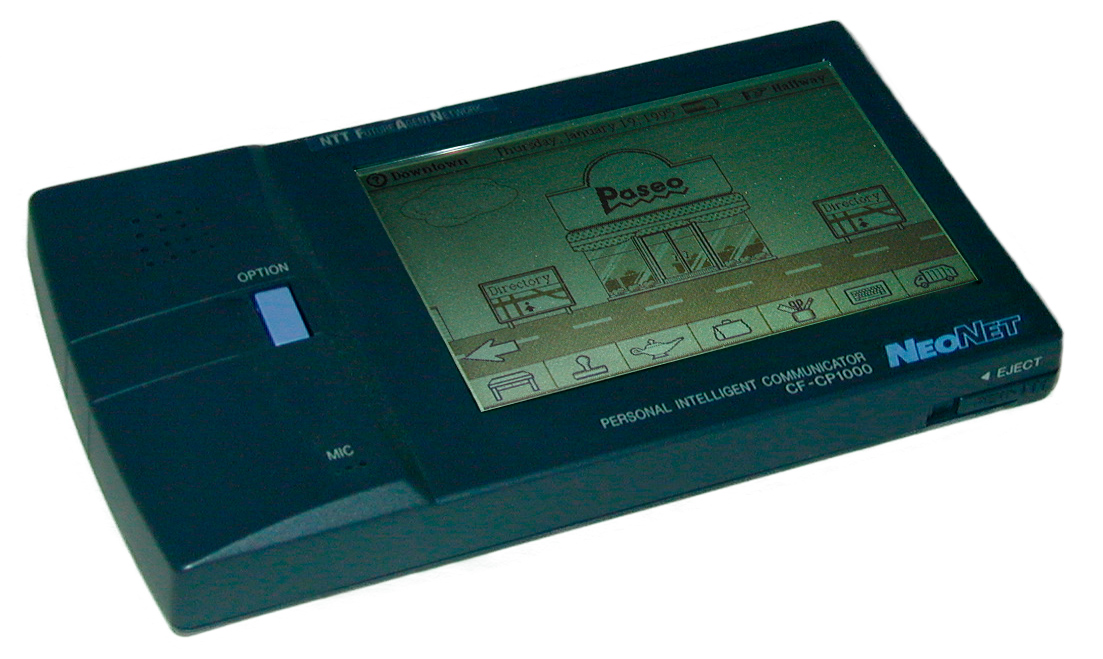Magic Cap
 Operating System: Magic Cap 1.5
Pros: Great form factor – very slim.
Cons: No rechargable battery.
History Nobody wanted to admit to creating NeoNet. It was the nameless, parentless child of… who? Many devices didn’t have labels on them, and the labeled ones often had their names taped over. As it happens, the guilty party was Matsushita, parent company of Panasonic. I’m still unsure why they never wanted to admit it–maybe to save face if they decided to can the project.
Operating System: Magic Cap 1.5
Pros: Great form factor – very slim.
Cons: No rechargable battery.
History Nobody wanted to admit to creating NeoNet. It was the nameless, parentless child of… who? Many devices didn’t have labels on them, and the labeled ones often had their names taped over. As it happens, the guilty party was Matsushita, parent company of Panasonic. I’m still unsure why they never wanted to admit it–maybe to save face if they decided to can the project.
 Operating System: Magic Cap 1.5
Pros: Great backlit screen, two PC Card slots, great battery, superb fit and finish.
Cons: Faster than PIC1000, but still slow.
History PIC-2000/Oak was an eagerly awaited device within General Magic. You could tell a buzz was going through the building when the first in-plastic prototype arrived. Everyone had to see it, find out more about it. And rightly so: it was a fantastic machine.
Operating System: Magic Cap 1.5
Pros: Great backlit screen, two PC Card slots, great battery, superb fit and finish.
Cons: Faster than PIC1000, but still slow.
History PIC-2000/Oak was an eagerly awaited device within General Magic. You could tell a buzz was going through the building when the first in-plastic prototype arrived. Everyone had to see it, find out more about it. And rightly so: it was a fantastic machine.
 Operating System: Magic Cap 1.0
Pros: Great battery, great rubberized paint.
Cons: Awful low-contrast screen, Extra-slow-mo user experience.
History The PIC-1000 has rightfully earned its place as a groundbreaking handheld device. (And no, not “groundbreaking” in the sense that if you drop it on the ground, it might break.) It was groundbreaking in that the PIC-1000 was the first Magic Cap device to ship. It went out the door before I got to Magic, but I’ve heard plenty of stories about the 1.
Operating System: Magic Cap 1.0
Pros: Great battery, great rubberized paint.
Cons: Awful low-contrast screen, Extra-slow-mo user experience.
History The PIC-1000 has rightfully earned its place as a groundbreaking handheld device. (And no, not “groundbreaking” in the sense that if you drop it on the ground, it might break.) It was groundbreaking in that the PIC-1000 was the first Magic Cap device to ship. It went out the door before I got to Magic, but I’ve heard plenty of stories about the 1.
Thanks to Wayne Sanderson for writing this FAQ entry.
Question:
I know there are two kinds of Motorola Envoy. Which is which- How are they
different physically? Internally?
Question:
I want a Motorola Envoy equipped with MagicCap 1.5. I see ads for
Motorola Envoys for sale every so often, but the sellers are either
unwilling or unable to tell me which device they are selling. How can
I tell the difference by just looking at a thumbnail snapshot?
Thanks to Wayne Sanderson for writing this FAQ entry.
Question:
I want to transfer text files from my desktop computer to the Notebook
on my MagicCap Communicator. What’s the best way to do this? [Magic Cap 1.0/1.5]
Thanks to Wayne Sanderson for writing this FAQ entry.
Question:
How do I connect to the Internet, use email, and browse the web? [Magic Cap 1.0/1.5]
 Operating System: Magic Cap 1.5
Pros: Great form factor – very slim.
Cons: No rechargable battery.
History Nobody wanted to admit to creating NeoNet. It was the nameless, parentless child of… who? Many devices didn’t have labels on them, and the labeled ones often had their names taped over. As it happens, the guilty party was Matsushita, parent company of Panasonic. I’m still unsure why they never wanted to admit it–maybe to save face if they decided to can the project.
Operating System: Magic Cap 1.5
Pros: Great form factor – very slim.
Cons: No rechargable battery.
History Nobody wanted to admit to creating NeoNet. It was the nameless, parentless child of… who? Many devices didn’t have labels on them, and the labeled ones often had their names taped over. As it happens, the guilty party was Matsushita, parent company of Panasonic. I’m still unsure why they never wanted to admit it–maybe to save face if they decided to can the project.






